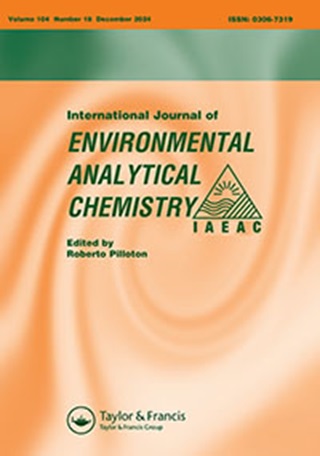液相色谱-高分辨率四极杆飞行时间质谱法分析法国农业土壤中农药
IF 2.5
4区 化学
Q3 CHEMISTRY, ANALYTICAL
International Journal of Environmental Analytical Chemistry
Pub Date : 2023-11-08
DOI:10.1080/03067319.2023.2277881
引用次数: 0
摘要
在法国,由于大量使用农药,农业土壤没有得到控制。四极杆质谱仪用于几十种农药的靶向分析,而高分辨率飞行时间四极杆质谱仪(QTOF-MS)可用于数百种农药的靶向和非靶向分析。本研究采用加压液萃取(PLE)、液相色谱(LC)和QTOF-MS相结合的方法对土壤进行了定向分析。该方法的开发对于开展土壤中的下一个可疑和非目标筛选是必要的,并已在土壤中的三嗪类、苯脲类和新兴农药中得到验证。使用标记的内部标准品对低水平(0.5至12.5µg L−1)和高水平(12.5至400µg L−1)的农药进行了内部校准。各农药标定曲线的决定系数R2均大于0.99。除DCPU和IPPU外,在40µg kg - 1和10µg kg - 1条件下,5种对照土壤中农药的平均回收率分别大于93.5%和106.2%,变异系数分别小于14.7%和22.5%。因此,对DCPU和IPPU的量化结果分别采用乘数因子2.5和1.7进行校正。该方法已被应用于法国卢瓦尔河谷中部地区40种土壤的选择。土壤中农药的定量限(LOQ)在0.005 ~ 0.175µg kg−1之间。土壤中检出最多的农药有7种。土壤中17种农药的检出率在10% ~ 50%之间,其中10种农药检出率极低(<10%)。三嗪类、苯脲类和新兴农药的平均浓度分别为0.730µg kg - 1 dw、1.367µg kg - 1 dw和7.638µg kg - 1 dw。40种土壤中均检测到DCPMU和环氧康唑。关键词:农药,土壤,压力液体萃取,液相色谱,飞行时间质谱感谢法国orlsamans的INRAE Info&Sols的同事,他们负责法国土壤质量监测网络(RMQS),感谢他们提供的土壤样品及其农业用途和植物检疫处理方面的信息。披露声明作者未报告潜在的利益冲突。本研究得到了印度国家农业、食品和环境研究所(INRAE)科学部门“AgroEcoSystem”的支持。本文章由计算机程序翻译,如有差异,请以英文原文为准。
Liquid chromatography - high-resolution quadrupole time-of-flight mass spectrometry analysis of pesticides in French agricultural soils
ABSTRACTAgricultural soils are not controlled in France for the massive use of pesticides. The quadrupole mass spectrometer is used for targeted analysis of a few dozen pesticides, while the high-resolution time-of-flight quadrupole mass spectrometer (QTOF-MS) allows both targeted and non-targeted analysis of hundreds of pesticides. In this study, a targeted method was developed in soils using pressurised-liquid extraction (PLE) and liquid chromatography (LC) coupled with a QTOF-MS. This method development was necessary to carry out next suspect and non-target screening in soils and has been validated for triazines, phenylureas and emerging pesticides in soils. The internal calibration of pesticides was validated for low levels (0.5 to 12.5 µg L−1) and high levels (12.5 to 400 µg L−1) using labelled internal standards. The determination coefficient (R2) of calibration curve of each pesticide was greater than 0.99. Excepted DCPU and IPPU, the mean recoveries of pesticides in five reference soils spiked at 40 µg kg−1 and 10 µg kg−1 were greater than 93.5% and 106.2%, and the variation coefficients lower than 14.7% and 22.5%, respectively. So, multiplier factors were applied to the quantification results of DCPU and IPPU, respectively, 2.5 and 1.7 for correction. This validated method has been applied to a selection of 40 French soils of Centre-Val de Loire region. The limit of quantification (LOQ) of pesticides varied between 0.005 and 0.175 µg kg−1 in soils. Seven pesticides were the most detected in soils. Seventeen pesticides were detected between 10 and 50% of cases and very low detection frequencies (<10%) were found for 10 pesticides in soils. The mean concentrations were 0.730 µg kg−1 dw for triazines, 1.367 µg kg−1 dw for phenylureas and 7.638 µg kg−1 dw for emerging pesticides. DCPMU and epoxiconazole were detected in all the 40 soils.KEYWORDS: Pesticidessoilpressurised-liquid extractionliquid chromatographytime-of-flightmass spectrometry AcknowledgmentsColleagues of INRAE Info&Sols in Orléans (France), responsible for the French Soil Quality Monitoring Network (RMQS), are gratefully acknowledged for providing the soil samples and informations about their agricultural uses and phytosanitary treatments.Disclosure statementNo potential conflict of interest was reported by the author(s).Additional informationFundingThis work was supported by ‘AgroEcoSystem’, a scientific department of INRAE (National Research Institute for Agriculture, Food and Environment).
求助全文
通过发布文献求助,成功后即可免费获取论文全文。
去求助
来源期刊
CiteScore
5.90
自引率
7.70%
发文量
373
审稿时长
4.4 months
期刊介绍:
International Journal of Environmental Analytical Chemistry comprises original research on all aspects of analytical work related to environmental problems. This includes analysis of organic, inorganic and radioactive pollutants in air, water, sediments and biota; and determination of harmful substances, including analytical methods for the investigation of chemical or metabolic breakdown patterns in the environment and in biological samples.
The journal also covers the development of new analytical methods or improvement of existing ones useful for the control and investigation of pollutants or trace amounts of naturally occurring active chemicals in all environmental compartments. Development, modification and automation of instruments and techniques with potential in environment sciences are also part of the journal.
Case studies are also considered, particularly for areas where information is scarce or lacking, providing that reported data is significant and representative, either spatially or temporally, and quality assured. Owing to the interdisciplinary nature of this journal, it will also include topics of interest to researchers in the fields of medical science (health sciences), toxicology, forensic sciences, oceanography, food sciences, biological sciences and other fields that, in one way or another, contribute to the knowledge of our environment and have to make use of analytical chemistry for this purpose.

 求助内容:
求助内容: 应助结果提醒方式:
应助结果提醒方式:


